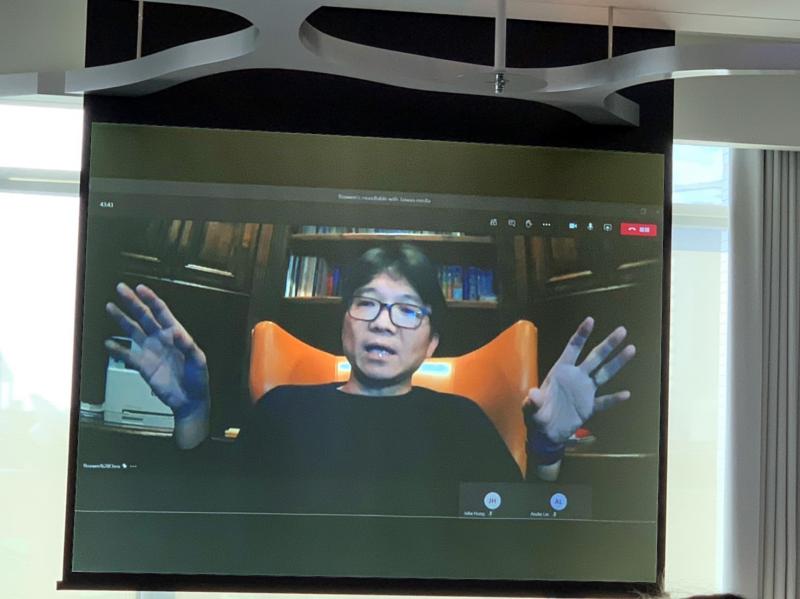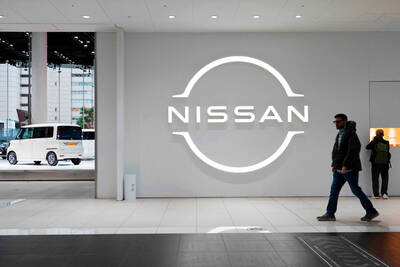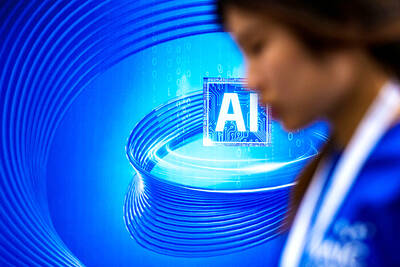Taiwan is to benefit from growing adoption of millimeter-wave (mmWave) technology, open platform base stations and new breeds of notebook computers powered by Arm Ltd chips, given its comprehensive semiconductor supply chains, a Qualcomm Inc executive said yesterday.
With high bandwidth of 28-gigahertz, mmWave technology is bringing gigabit-speed and low latency similar with fiber networks, enabling new applications that 4G technology cannot support, Qualcomm senior vice president of manufacturing technology and operations Roawen Chen (陳若文) said at a virtual meeting.
More than half of mmWave production value would come from non-smartphone areas that include smart manufacturing and autonomous systems, Chen said.

Photo: Vanessa Cho, Taipei Times
Qualcomm expects mmWave technology to help drive US$13.2 trillion in production value in 2035, with about US$4.77 trillion coming from the smart manufacturing segment.
Smartphones are to generate much lower production value at US$2.22 trillion, the company said.
Devices supporting mmWave technology consume much more silicon content, or chips, than those for sub-6-gigahertz technology and 4G LTE technology, Chen said.
“As Taiwan has the world’s most comprehensive [semiconductor] ecosystem, the mmWave technology will be a boon to the country,” he said.
Using base stations based on open radio access network (O-RAN), or virtualized radio access network (vRAN), opens the door for Taiwan’s networking equipment manufacturers to make inroads into the telecom sector by supplying small cell base stations, he said.
Such stations are the most important building block for O-RAN networks, Chen said.
The telecom segment is a much “bigger and sweeter pie” than the data communications segment, which local networking equipment makers now supply Wi-Fi products, he added.
An O-RAN-based or vRAN-based base station works on an open platform, making it easier for new telecoms to build 5G networks fast and cost-effectively.
Such stations are different from traditional and closed-loop base stations designed by existing suppliers, Nokia Oyj, Ericsson AB and Huawei Technologies Inc (華為), Chen said.
Geopolitical tensions between the US and China are providing an opportunity for Taiwanese companies to build their presence in the telecom market, as most countries are trying to avoid Chinese-made base stations due to national security concerns, he said.
Equipment maker Sercomm Corp (中磊) said it has been developing small cell base stations for more than a decade, but its stations had not been adopted until this year — by Chunghwa Telecom Co (中華電信), which is building a 5G mmWave private enterprise network for ASE Technology Holding Co (ASE, 日月光投控).
Telecoms have shown a stronger interest over the past six months in deploying O-RAN-based base stations due to their lower costs, Chen said.
Japan’s Rakuten Mobile Inc was the first telecom to build its 5G network using virtualized techniques, he said.
Apple Inc’s announcement that it would use its own ARM-based M1 chip instead of Intel Corp chips for its new notebook computer next year would create new opportunities for Taiwanese firms, as they no longer have to rely on Window’s Intel structure to build their computers, Chen said.
Taiwanese companies can design and make their chips for PCs and servers in Taiwan, a sign that most of the PC value chain is going to stay in Taiwan, he said.

TEMPORARY TRUCE: China has made concessions to ease rare earth trade controls, among others, while Washington holds fire on a 100% tariff on all Chinese goods China is effectively suspending implementation of additional export controls on rare earth metals and terminating investigations targeting US companies in the semiconductor supply chain, the White House announced. The White House on Saturday issued a fact sheet outlining some details of the trade pact agreed to earlier in the week by US President Donald Trump and Chinese President Xi Jinping (習近平) that aimed to ease tensions between the world’s two largest economies. Under the deal, China is to issue general licenses valid for exports of rare earths, gallium, germanium, antimony and graphite “for the benefit of US end users and their suppliers

Dutch chipmaker Nexperia BV’s China unit yesterday said that it had established sufficient inventories of finished goods and works-in-progress, and that its supply chain remained secure and stable after its parent halted wafer supplies. The Dutch company suspended supplies of wafers to its Chinese assembly plant a week ago, calling it “a direct consequence of the local management’s recent failure to comply with the agreed contractual payment terms,” Reuters reported on Friday last week. Its China unit called Nexperia’s suspension “unilateral” and “extremely irresponsible,” adding that the Dutch parent’s claim about contractual payment was “misleading and highly deceptive,” according to a statement

Nissan Motor Co has agreed to sell its global headquarters in Yokohama for ¥97 billion (US$630 million) to a group sponsored by Taiwanese autoparts maker Minth Group (敏實集團), as the struggling automaker seeks to shore up its financial position. The acquisition is led by a special purchase company managed by KJR Management Ltd, a Japanese real-estate unit of private equity giant KKR & Co, people familiar with the matter said. KJR said it would act as asset manager together with Mizuho Real Estate Management Co. Nissan is undergoing a broad cost-cutting campaign by eliminating jobs and shuttering plants as it grapples

The Chinese government has issued guidance requiring new data center projects that have received any state funds to only use domestically made artificial intelligence (AI) chips, two sources familiar with the matter told Reuters. In recent weeks, Chinese regulatory authorities have ordered such data centers that are less than 30 percent complete to remove all installed foreign chips, or cancel plans to purchase them, while projects in a more advanced stage would be decided on a case-by-case basis, the sources said. The move could represent one of China’s most aggressive steps yet to eliminate foreign technology from its critical infrastructure amid a